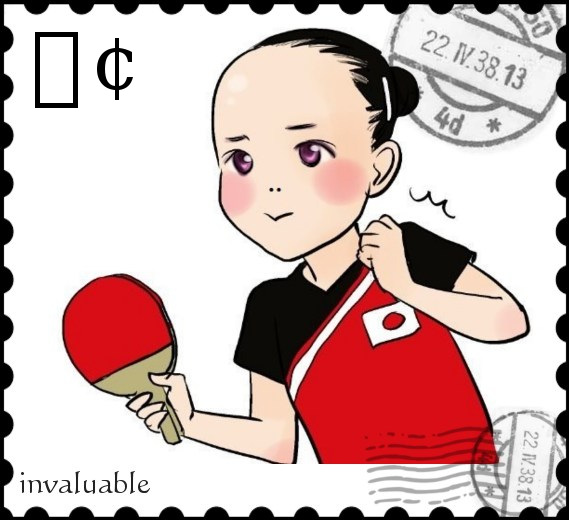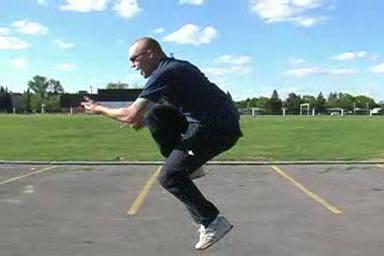|
|
|
Concave vs. Convex Loop (Which is which/better?) |

|
Post Reply 
|
Page 123> |
| Author | ||||||
king_pong 
Silver Member 

Joined: 06/29/2010 Location: Minneapolis Status: Offline Points: 889 |
 Post Options Post Options
 Thanks(0) Thanks(0)
 Quote Quote  Reply Reply
 Topic: Concave vs. Convex Loop (Which is which/better?) Topic: Concave vs. Convex Loop (Which is which/better?)Posted: 06/21/2012 at 3:44am |
|||||
|
Not sure I'm following it when people use these terms. I was wondering of someone could point me in the right direction. I notice at least two distinct main looping styles of the CNT. The first is an aggressive loop-drive, in which the hand starts low and ends very high with the blade vertical and very high above the head. The crux of the elbow is often right in front of the nose on the follow-through (think Ma Long, Yan An, Fan Bo). I consider this one to be "concave". Then there is a loop which also starts low, but when the stroke terminates the blade ends more across the head horizontally, with the elbow pointed outwards, almost like they're throwing the ball rather than hitting it (think Wang Hao, Zhang Jike, Chen Qi). Maybe this is more of a "pure-loop". I consider this one to be the "convex". Two distinct styles (Ma Long vs. Chen Qi): It seems these two distinctive styles may have developed from two of the sports' and two China's most heralded players -- Kong Linghui and Liu Guoliang. When I watch them in their video series -- "Excellent World Champions Teach You How To Play Table Tennis (16DVDs)", I noticed how different the two players' forehands were. Kong Linghui "whipping hand/wrist loop"-- Liu Guoliang "driving loop"-- I understand that Guoliang was more of a hitter, while Kong was a pure looper, but Guoliang's style (what I believe to be the "Concave-style FH") seems to be emerging as the more dominant top-spinning FH amongst today's CNT shakehanders, with its more open striking of the ball and elliptical path of the recovery arm. Maybe someone could speak to this, explaining this for this for those of us who are a bit newer to the game. Might spare from trying to mimic extinct or outgoing FH technique styles. Thank you.  Edited by king_pong - 06/21/2012 at 3:44am |
||||||
 |
||||||
| Sponsored Links | ||||||
 |
||||||
doraemon 
Gold Member 
Joined: 05/14/2007 Location: USA Status: Offline Points: 1738 |
 Post Options Post Options
 Thanks(0) Thanks(0)
 Quote Quote  Reply Reply
 Posted: 06/21/2012 at 3:49am Posted: 06/21/2012 at 3:49am |
|||||
|
Sorry, but when I read "concave" vs "convex" loop, I am immediately terrified that "person" is back with haunting threads.....
 All of you know who I meant...... Sorry King_Pong, for the irrelevant reply.... Edited by doraemon - 06/21/2012 at 3:50am |
||||||
 |
||||||
kenneyy88 
Premier Member 
Joined: 01/06/2006 Location: United States Status: Offline Points: 4074 |
 Post Options Post Options
 Thanks(0) Thanks(0)
 Quote Quote  Reply Reply
 Posted: 06/21/2012 at 3:50am Posted: 06/21/2012 at 3:50am |
|||||
|
I don't think many pros do any of these anymore. Closest thing is like Ma long swinging up, then on followthrough he closes the racket face.
|
||||||
 |
||||||
king_pong 
Silver Member 

Joined: 06/29/2010 Location: Minneapolis Status: Offline Points: 889 |
 Post Options Post Options
 Thanks(0) Thanks(0)
 Quote Quote  Reply Reply
 Posted: 06/21/2012 at 5:30am Posted: 06/21/2012 at 5:30am |
|||||
Do "which" anymore? Can you elaborate? Thank you.
|
||||||
 |
||||||
zeio 
Premier Member 
Joined: 03/25/2010 Status: Offline Points: 10833 |
 Post Options Post Options
 Thanks(0) Thanks(0)
 Quote Quote  Reply Reply
 Posted: 06/21/2012 at 6:32am Posted: 06/21/2012 at 6:32am |
|||||
|
This is in fact a legit topic worth digging for.
The Japanese magazine 桌球王国 World Table Tennis has published articles regarding the differences in the loop stroke when playing tacky and grippy rubbers. It is claimed that the grazing loop stroke is more suited for tacky rubbers, whereas the hitting loop stroke is suitable for high tension or tensor rubbers. A picture of Wang Liqin pulling off a loopkill is even included. Parts of those articles have been in wide circulation among various forums. http://www.pingpang.info/bbs/dispbbs.asp?id=215087&authorid=83433&boardid=2 http://www.pingpang.info/bbs/TopicOther.asp?t=5&BoardID=235&id=201008 http://sundns.org/discuZ/viewthread.php?action=printable&tid=266525 Edited by zeio - 06/21/2012 at 6:33am |
||||||
|
Viscaria FL - 91g
+ Neo H3 2.15 Blk - 44.5g(55.3g uncut bare) + Hexer HD 2.1 Red - 49.3g(68.5g 〃 〃) = 184.8g |
||||||
 |
||||||
popperlocker 
Gold Member 
Joined: 03/24/2008 Location: United States Status: Offline Points: 1753 |
 Post Options Post Options
 Thanks(0) Thanks(0)
 Quote Quote  Reply Reply
 Posted: 06/21/2012 at 6:43am Posted: 06/21/2012 at 6:43am |
|||||
|
Depends on your equipment and physical attributes. The CNT members all use slightly different body mechanics. The only person that can answer your question is yourself. Try out both concave and convex and decide which one you like better.
Some rubbers are great for concave looping and others for convex looping. So it depends what you're using too. As I was watching your example video, I feel it's a crime to classify the CNT members as convex or concave. I view it more complex than that, like walking. Every person walks a little different, because they have different: body weights, height, muscles, bone structure, training, influences, handicaps, injuries, abnormalities, personalities, mood, etc.
|
||||||
 |
||||||
JohnnyChop 
Gold Member 
Joined: 05/02/2010 Location: Toronto Status: Offline Points: 1159 |
 Post Options Post Options
 Thanks(0) Thanks(0)
 Quote Quote  Reply Reply
 Posted: 06/21/2012 at 10:44am Posted: 06/21/2012 at 10:44am |
|||||
|
Isn't LGL short pip forhand? That would definitely change the stroke!!!
|
||||||
|
729 Battle 2 Yasaka Goibao 5 Nittaku Fastarc G1
Nittaku Fastarc G1 Butterfly Cypress Max |
||||||
 |
||||||
king_pong 
Silver Member 

Joined: 06/29/2010 Location: Minneapolis Status: Offline Points: 889 |
 Post Options Post Options
 Thanks(0) Thanks(0)
 Quote Quote  Reply Reply
 Posted: 06/21/2012 at 10:58am Posted: 06/21/2012 at 10:58am |
|||||
That's great, but what do these threads say? I saw in the last one that it appeared that they were addressing the issue of blade angle during the stroke (either closing or opening). It appeared that they were implying that the closing-stroke made a lower trajectory, but I couldn't read the text. Can you translate?
 |
||||||
 |
||||||
Leshxa 
Gold Member 
Joined: 01/03/2009 Location: United States Status: Offline Points: 1917 |
 Post Options Post Options
 Thanks(0) Thanks(0)
 Quote Quote  Reply Reply
 Posted: 06/21/2012 at 11:20am Posted: 06/21/2012 at 11:20am |
|||||
|
I think this will help a lot. Look at the section 14.
http://protabletennis.net/content/mechanics-table-tennis |
||||||
|
Back to table tennis...
|
||||||
 |
||||||
racquetsforsale 
Gold Member 
Joined: 10/02/2010 Location: at the table Status: Offline Points: 1268 |
 Post Options Post Options
 Thanks(0) Thanks(0)
 Quote Quote  Reply Reply
 Posted: 06/21/2012 at 11:56am Posted: 06/21/2012 at 11:56am |
|||||
|
I think the concave and convex trajectories occur naturally --- the more you swing forward and less upward, the more convex ("positive" arc in the article Leshxa referenced) your swing is; and the more you swing upward and less forward the more concave ("negative" arc) your swing is.
You probably already use the concave stroke when brush looping against underspin and the convex stroke when looping against topspin close to the table.
|
||||||
 |
||||||
king_pong 
Silver Member 

Joined: 06/29/2010 Location: Minneapolis Status: Offline Points: 889 |
 Post Options Post Options
 Thanks(0) Thanks(0)
 Quote Quote  Reply Reply
 Posted: 06/21/2012 at 3:08pm Posted: 06/21/2012 at 3:08pm |
|||||
Thank you. This is very informative. The author definitely knows what he is talking about. It is a little bit over my head, but I will read it more than once. I think I've trained in a FH stroke that follows the negative-arc trajectory, but have recently become aware that many powerful top pros' FHs follow a more positive-arc (Ma Long being the most outstanding). I'm experimenting with that stroke trajectory now. It seems to be a more powerful FH, with the additional benefit of recovering to a more neutral position for a possible backhand should the opponent force the situation. The article mentions the importance of stroke recovery, but does not specify which stroke arc is to be preferred for that. I feel that the positive-arc gives the best advantage for a potential follow-up backhand.  |
||||||
 |
||||||
racquetsforsale 
Gold Member 
Joined: 10/02/2010 Location: at the table Status: Offline Points: 1268 |
 Post Options Post Options
 Thanks(0) Thanks(0)
 Quote Quote  Reply Reply
 Posted: 06/21/2012 at 4:29pm Posted: 06/21/2012 at 4:29pm |
|||||
This seems to go against the perception that most Chinese players drive or hit through the ball more than their European counterparts when looping. Even a famous Chinese coach has stated the same thing.
|
||||||
 |
||||||
king_pong 
Silver Member 

Joined: 06/29/2010 Location: Minneapolis Status: Offline Points: 889 |
 Post Options Post Options
 Thanks(0) Thanks(0)
 Quote Quote  Reply Reply
 Posted: 06/21/2012 at 6:41pm Posted: 06/21/2012 at 6:41pm |
|||||
I think the statement is correct -- that it is easier to get a blistering brush-loop with tacky rubber, while bouncy-grippy rubber more easily facilitates a loop-drive -- but since it is possible to do either with either rubber, the CNT has discovered that driving with their harder-tackier rubber is, for some reason, better than the traditional brush-looping. Perhaps it is the arc that it produces, outlined in the article that Lexsha posted above -- http://protabletennis.net/content/mechanics-table-tennis. |
||||||
 |
||||||
zeio 
Premier Member 
Joined: 03/25/2010 Status: Offline Points: 10833 |
 Post Options Post Options
 Thanks(0) Thanks(0)
 Quote Quote  Reply Reply
 Posted: 06/22/2012 at 8:38am Posted: 06/22/2012 at 8:38am |
|||||
For a start, the first two threads are reviews done by a renowned reviewer from Taiwan under the name of 桂花田. He often cites material from that magazine to support his assertions. While I find most of those insights informative, certain portrayals within those articles are exaggerated and hence not representative of what is really taking place in reality. The picture in which the lady demonstrates the service motion where the ball literally rolls over the rubber from end to end is one such depiction, as opposed to this real-world example. The last one is about how the thread starter feels the European stranglehold on the forehand loop stroke is ruined at the hands of the current crop of loopers, e.g. Boll, Maze etc. He uses the tacky/grippy image to help illustrate that their having the blade face parallel with the endline of the table as the root cause of poor power and jerky transition, as opposed to the angled contact of the Chinese, when seen from the side. Yet, the picture of Wang Liqin's loopkill clearly shows otherwise. What the OP fails to take into account is the fact that different situations call for different strokes. Shot placement, contact point, body stance and so on all have an effect on one's swing. |
||||||
|
Viscaria FL - 91g
+ Neo H3 2.15 Blk - 44.5g(55.3g uncut bare) + Hexer HD 2.1 Red - 49.3g(68.5g 〃 〃) = 184.8g |
||||||
 |
||||||
Imago 
Premier Member 
Joined: 07/19/2009 Location: Sofia Status: Offline Points: 5897 |
 Post Options Post Options
 Thanks(0) Thanks(0)
 Quote Quote  Reply Reply
 Posted: 06/22/2012 at 10:24am Posted: 06/22/2012 at 10:24am |
|||||
Kind of eugenic/rasist statement.
|
||||||
 |
||||||
zeio 
Premier Member 
Joined: 03/25/2010 Status: Offline Points: 10833 |
 Post Options Post Options
 Thanks(0) Thanks(0)
 Quote Quote  Reply Reply
 Posted: 06/22/2012 at 12:46pm Posted: 06/22/2012 at 12:46pm |
|||||
I can understand where racquetsforsale is coming from. Liu Guozheng has been quoted for commenting on Chen Qi having more of a wrapping motion than other players, yet he happens to generate more power than would have been thought possible. Edited by zeio - 06/22/2012 at 12:47pm |
||||||
|
Viscaria FL - 91g
+ Neo H3 2.15 Blk - 44.5g(55.3g uncut bare) + Hexer HD 2.1 Red - 49.3g(68.5g 〃 〃) = 184.8g |
||||||
 |
||||||
racquetsforsale 
Gold Member 
Joined: 10/02/2010 Location: at the table Status: Offline Points: 1268 |
 Post Options Post Options
 Thanks(0) Thanks(0)
 Quote Quote  Reply Reply
 Posted: 06/22/2012 at 12:57pm Posted: 06/22/2012 at 12:57pm |
|||||
|
This is what I'm referring to: Wu Jing Ping on the FH; at the end of the article, he mentions that Chinese players tend to brush more because they use tacky rubbers, as opposed to their European counterparts who drive more with their grippy and elastic rubbers. |
||||||
 |
||||||
V-Griper 
Silver Member 

Joined: 09/19/2011 Location: United States Status: Offline Points: 879 |
 Post Options Post Options
 Thanks(0) Thanks(0)
 Quote Quote  Reply Reply
 Posted: 06/22/2012 at 1:37pm Posted: 06/22/2012 at 1:37pm |
|||||
|
I may be wrong but it seems to me that the the curve of the stroke, and the relatively closed or open paddle condition, is largely determined by where the ball is taken off the bounce.
If you take the ball early, anywhere up to, and including, slightly after TOB (top of bounce) and the ball is above net height, I think it would be preferable to have "positive" arc loop stroke and emphasize a relatively closed paddle face. It also facilitates over the table looping. If the ball is taken much after TOB and below net height it would then be preferable to use the "negative" arc loop stroke with a more open paddle face. The arc of the ball as it descends requires a more vertical "lifting" action. Also, of course, when you are stroking underspin. Of course each individuals adjustment is different. 
Examples- Positive arc Negative arc Edited by V-Griper - 06/22/2012 at 2:16pm |
||||||
 |
||||||
king_pong 
Silver Member 

Joined: 06/29/2010 Location: Minneapolis Status: Offline Points: 889 |
 Post Options Post Options
 Thanks(0) Thanks(0)
 Quote Quote  Reply Reply
 Posted: 06/22/2012 at 6:51pm Posted: 06/22/2012 at 6:51pm |
|||||
|
Excellent point, excellent post, V-griper! Thanks. I think you're right.

|
||||||
 |
||||||
zeio 
Premier Member 
Joined: 03/25/2010 Status: Offline Points: 10833 |
 Post Options Post Options
 Thanks(0) Thanks(0)
 Quote Quote  Reply Reply
 Posted: 06/23/2012 at 8:48am Posted: 06/23/2012 at 8:48am |
|||||
Wu Jingping's article, at the time of writing(2005 as indicated by one source), did point out that the forehand loop of Chinese penholders lacked power, a trait common among players owing to the short-pips hitter style. And so he had made it a first priority and had forced Wang Hao and Ma Lin to practice hitting harder. The notion that the Chinese hit harder probably first took root a decade ago along with Wang Liqin's first claim of the WTTC title. Duan Xiang(段翔), deputy director of R&D of the CTTA, uses the term "扭轉爆發鞭沖技術(Rotation-induced Explosion Whip-like [Forward"> Loop Technique, literally)" to separate Wang Liqin's forehand loop from the rest whom he describes as "加速制動擺沖技術(Acceleration-Braking Pendulum-like [Forward] Loop Technique)". The latter is likely an extension to the term "加速制動(Acceleration-Braking)", first coined by Zhuang Zedong, who takes a minimalistic approach to stroke mechanics where great emphasis is placed on maximizing acceleration before contact and brakes to a halt as soon as the ball takes off to reduce the time of recovery. According to Duan's words, what sets Wang Liqin apart is the unique[at that time] kinetic chain he uses to harness the rotational kinetic energy by coupling the arm, waist, crotch and so on. Edited by zeio - 06/23/2012 at 8:48am |
||||||
|
Viscaria FL - 91g
+ Neo H3 2.15 Blk - 44.5g(55.3g uncut bare) + Hexer HD 2.1 Red - 49.3g(68.5g 〃 〃) = 184.8g |
||||||
 |
||||||
bluebucket 
Platinum Member 
Joined: 02/20/2011 Location: 16 Status: Offline Points: 2882 |
 Post Options Post Options
 Thanks(0) Thanks(0)
 Quote Quote  Reply Reply
 Posted: 06/23/2012 at 9:44am Posted: 06/23/2012 at 9:44am |
|||||
|
There is no such thing as a convex or concave loop, if you have the spare time and muscles to make that shape movement when looping you are simply doing it wrong.
|
||||||
 |
||||||
mikepong 
Gold Member 

Joined: 03/09/2011 Location: Philippines Status: Offline Points: 1202 |
 Post Options Post Options
 Thanks(0) Thanks(0)
 Quote Quote  Reply Reply
 Posted: 06/23/2012 at 9:57am Posted: 06/23/2012 at 9:57am |
|||||
wow thanx man, i really didnt understand what we were talking about here until i saw the illustration, and i agree that the choice of loop depends on what ball is coming to you
|
||||||
|
Viscaria
FH: Tenergy 05 black BH: Tenergy 05 red |
||||||
 |
||||||
zeio 
Premier Member 
Joined: 03/25/2010 Status: Offline Points: 10833 |
 Post Options Post Options
 Thanks(0) Thanks(0)
 Quote Quote  Reply Reply
 Posted: 06/23/2012 at 1:21pm Posted: 06/23/2012 at 1:21pm |
|||||
|
For those who have chosen to jump to conclusions, I invite them to answer the following question.
Given two balls released from the top at the same time, which one reaches the bottom in the shortest time, Red or Green? Why?  |
||||||
|
Viscaria FL - 91g
+ Neo H3 2.15 Blk - 44.5g(55.3g uncut bare) + Hexer HD 2.1 Red - 49.3g(68.5g 〃 〃) = 184.8g |
||||||
 |
||||||
vvk1 
Gold Member 

Joined: 11/14/2009 Location: UK Status: Offline Points: 1925 |
 Post Options Post Options
 Thanks(0) Thanks(0)
 Quote Quote  Reply Reply
 Posted: 06/23/2012 at 1:41pm Posted: 06/23/2012 at 1:41pm |
|||||
|
A famous English dude figured this out in 1696 :-)
|
||||||
 |
||||||
V-Griper 
Silver Member 

Joined: 09/19/2011 Location: United States Status: Offline Points: 879 |
 Post Options Post Options
 Thanks(0) Thanks(0)
 Quote Quote  Reply Reply
 Posted: 06/23/2012 at 6:50pm Posted: 06/23/2012 at 6:50pm |
|||||
Sliding or rolling? Friction? Off the cuff I would say green(if they are rolling, or sliding with no friction). Larger initial acceleration(linear and rotational) in the beginning and greater momentum and inertia at the end to maintain velocity. The green ball is accelerating/moving/rolling a lot faster. You will have to explain the relevance. I don't get it.
Edited by V-Griper - 06/23/2012 at 6:52pm |
||||||
 |
||||||
pnachtwey 
Platinum Member 
Joined: 03/09/2010 Location: Vancouver, WA Status: Offline Points: 2035 |
 Post Options Post Options
 Thanks(0) Thanks(0)
 Quote Quote  Reply Reply
 Posted: 06/23/2012 at 8:56pm Posted: 06/23/2012 at 8:56pm |
|||||
I think it is impossible to avoid convex or concave loops because our arm rotate around sockets. However, I I agree you are probably doing it wrong if you have much of a convex or concave loop. If your timing isn't perfect the ball will go low or high if you paddle attitude is changing during the stroke. I try to keep the attitude of my paddle constant during the time that impact can occur and my swing in a plane so that my stroke is not as timing dependent. If I hit the ball a millisecond early or late it won't make any difference. I find this thread amusing. So those of you that argue one way or another, how do you justify your statements? How can you justify the potential errors due to the ball hitting a few millisecond earlier or latter? What difference does a 0.1 degree difference in the paddle attitude make over 3 meters or more? I also know that the ball doesn't care about the stroke leading up to and after impact. Only the attitude and rate of change in attitude of the paddle make a difference as well as the stoke and rate of change in the stroke directions DURING the stroke make a difference. |
||||||
 |
||||||
BH-Man 
Premier Member 

Joined: 02/05/2007 Location: United States Status: Offline Points: 5042 |
 Post Options Post Options
 Thanks(0) Thanks(0)
 Quote Quote  Reply Reply
 Posted: 06/23/2012 at 9:06pm Posted: 06/23/2012 at 9:06pm |
|||||
Good comparison. Red ball has shorter path to go to finish and has constant acelleration if friction is a non-factor. Green ball has a longer path, but achieves higher velocity before halfway point.
|
||||||
|
Korea Foreign Table Tennis Club
Search for us on Facebook: koreaforeignttc |
||||||
 |
||||||
icontek 
Premier Member 

This is FPS Doug Joined: 10/31/2006 Location: Maine, US Status: Offline Points: 5222 |
 Post Options Post Options
 Thanks(0) Thanks(0)
 Quote Quote  Reply Reply
 Posted: 06/23/2012 at 10:37pm Posted: 06/23/2012 at 10:37pm |
|||||
I understand what you are saying, I think... But why then does followthrough make so much difference in consistency, power and placement of a stroke? For example: Takie a mid distance BH topspin, with the backswing from the hip, rotation from the leading shoulder, and uncoiling of the core while contacting the ball in front into a big followthrough that ends with the arm high, out to the right (assuming right handed)... Why does the larger arc (relative to a smaller backswing and smaller followthrough) require less adjustment against incoming spin? In other words, why do bigger mechanics seem to ignore incoming spin more than smaller mechanics? Is it because there is a larger section of the arc where a "reasonably good shot" is possible? |
||||||
 |
||||||
IllSonny 
Super Member 
Joined: 07/24/2011 Location: Saint Paul Status: Offline Points: 191 |
 Post Options Post Options
 Thanks(0) Thanks(0)
 Quote Quote  Reply Reply
 Posted: 06/23/2012 at 10:44pm Posted: 06/23/2012 at 10:44pm |
|||||
|
I gotta say, as a rookie player, this is the most interesting thread I ever read... Sorry for the off topic post... :)
|
||||||
|
Stiga Infinity VPS Legend
H3 Galaxy Moon |
||||||
 |
||||||
pnachtwey 
Platinum Member 
Joined: 03/09/2010 Location: Vancouver, WA Status: Offline Points: 2035 |
 Post Options Post Options
 Thanks(0) Thanks(0)
 Quote Quote  Reply Reply
 Posted: 06/23/2012 at 11:53pm Posted: 06/23/2012 at 11:53pm |
|||||
Easy. If the paddle is going to maintain the same attitude and speed during the stroke then you can't change anything until AFTER impact. After impact it is best to get back to the ready position.
Yes, but that is due to the limitations on how fast you can decelerate the paddle AFTER the impact.
I am not sure what you mean. I don't think the length of the arc has much do do with being less sensitive to the spin except for the fact it is easier to move the paddle forward faster with a bigger stroke. It requires less acceleration and deceleration. Spin causes the ball to move tangentially to the ball impact. The impact itself causes the ball to 'reflect' off the paddle. Assume the ball is hitting the paddle straight on or normal to the paddle and there is spin on it. The ball will spin off to the side at a certain rate. If if spins off to the side at the same rate it bounces back in the normal direction the ball will bounce off the paddle at an angle of 45 degrees. Now what if the ball hits with the same spin but you hit the ball so the ball is returning 10 times faster in the normal direction. Then the paddle angle will be only 5.7 degrees from normal. ATAN(normal speed/tangential speed) It is the same principle behind why faster paddles have lower 'throw angles', but it really depends on how fast you hit the ball.
No it is simple vector trigonometry.
No, it is simply that hitting the ball faster means the spin has less effect on the angle of return. If you could hit the ball infinitely fast the spin would have almost no effect on the return angle of the ball. I think there are many that intuitively realize this when they say 'hit through spin'. |
||||||
 |
||||||
Post Reply 
|
Page 123> |
|
Tweet
|

|
| Forum Jump | Forum Permissions  You cannot post new topics in this forum You cannot reply to topics in this forum You cannot delete your posts in this forum You cannot edit your posts in this forum You cannot create polls in this forum You cannot vote in polls in this forum |
|
Forum Home | Go to the Forums | Forum Help | Disclaimer
MyTableTennis.NET is the trading name of Alex Table Tennis Ltd. |